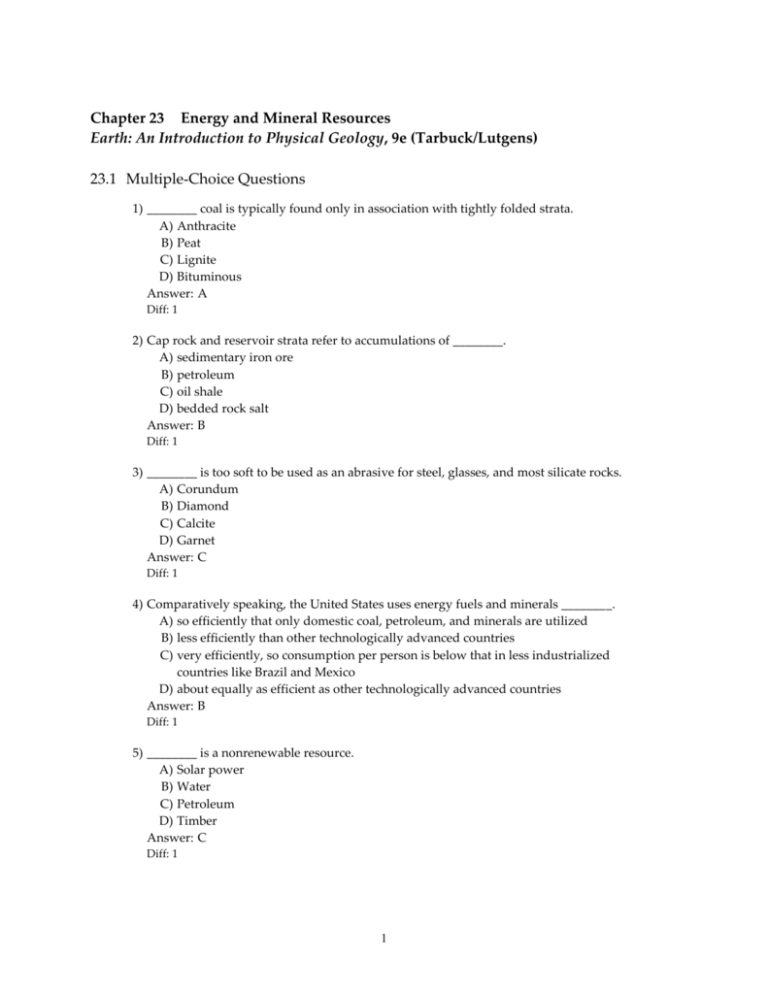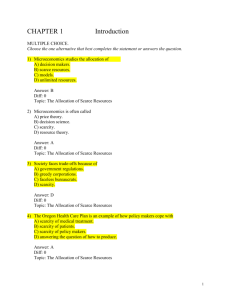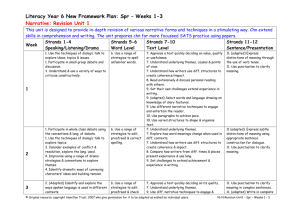Earth,Tests,Ch23
advertisement

Chapter 23 Energy and Mineral Resources Earth: An Introduction to Physical Geology, 9e (Tarbuck/Lutgens) 23.1 Multiple-Choice Questions 1) ________ coal is typically found only in association with tightly folded strata. A) Anthracite B) Peat C) Lignite D) Bituminous Answer: A Diff: 1 2) Cap rock and reservoir strata refer to accumulations of ________. A) sedimentary iron ore B) petroleum C) oil shale D) bedded rock salt Answer: B Diff: 1 3) ________ is too soft to be used as an abrasive for steel, glasses, and most silicate rocks. A) Corundum B) Diamond C) Calcite D) Garnet Answer: C Diff: 1 4) Comparatively speaking, the United States uses energy fuels and minerals ________. A) so efficiently that only domestic coal, petroleum, and minerals are utilized B) less efficiently than other technologically advanced countries C) very efficiently, so consumption per person is below that in less industrialized countries like Brazil and Mexico D) about equally as efficient as other technologically advanced countries Answer: B Diff: 1 5) ________ is a nonrenewable resource. A) Solar power B) Water C) Petroleum D) Timber Answer: C Diff: 1 1 6) The world's largest plant for generating electricity from tides is ________. A) along the coast of California just north of San Francisco B) in the Rance River estuary, Brittany, along the Atlantic coast of France C) along the mouth of the Amazon River in Brazil D) in the Netherlands along the Rhine River delta Answer: B Diff: 1 7) Vein- or fissure-filling deposits of lead and zinc minerals would be more common in ________. A) impactites and shattered rock of a meteorite impact zone B) rocks of a contact-metamorphic zone formed around a shallow, granite pluton C) rocks formed in a deep, high-grade, regional-metamorphic zone D) rhyolitic lava flows interbedded with pyroclastics Answer: B Diff: 1 8) Ore deposits of ________ form by prolonged, intense, tropical weathering of specific kinds of bedrock. A) silver B) mercury C) aluminum D) magnesium Answer: C Diff: 1 9) Chemical decomposition of ________ produces acidic soil waters that can cause secondary enrichment in copper and in other ore deposits. A) calcite B) quartz C) bauxite D) pyrite Answer: D Diff: 1 10) Bauxite is an ore of ________. A) iron B) tin C) gold D) aluminum Answer: D Diff: 1 2 11) Detrital grains of ________ are not likely to be concentrated in placer deposits. A) native gold B) diamond C) corundum D) gypsum Answer: D Diff: 1 12) The Geysers and Larderello are ________ facilities in California and Italy, respectively. A) geothermal power B) hydroelectric C) copper mining D) diamond mining Answer: A Diff: 1 13) ________ are both calcium-bearing minerals. A) Calcite and gypsum B) Bauxite and kaolin C) Quartz and plagioclase D) Halite and sylvite Answer: A Diff: 1 14) Which one of the following is a false statement concerning the Bingham Canyon mine? A) is the largest, open-pit copper mine in North America B) located in Utah near Salt Lake City C) most of the mineralized rock is part of an igneous rock pluton D) the ore contains, on average, more than three percent by weight of copper Answer: D Diff: 1 15) ________ are important fertilizer minerals with their correct elements. A) Halite and calcite B) Sylvite and gypsum C) Cassiterite and albite D) Apatite and sylvite Answer: D Diff: 1 16) ________ are used as abrasives. A) Diamond and garnet B) Calcite and gypsum C) Apatite and galena D) Talc and graphite Answer: A Diff: 1 3 17) By the year 2005, the world's population will probably have just reached or slightly surpassed ________ people. A) 70 million B) 7 billion C) 70 billion D) 7 million Answer: B Diff: 1 18) The United States, with about 6 % of the world's population, uses about ________ of the world's total, annual, energy production. A) 9% B) 30% C) 3% D) 15% Answer: B Diff: 1 19) ________ supplies the largest percentage of energy consumed annually in the United States. A) Petroleum B) Coal C) Hydroelectricity D) Uranium Answer: A Diff: 1 20) ________ accounts for the majority of the coal burned annually in the United States. A) Production of carbon black, synthetic diamonds, and graphite B) Coke manufacture for the steel industry C) Home and industrial space heating D) Generation of electricity Answer: D Diff: 1 21) Of the following fossil fuels, ________ is most likely to have the lowest sulfur content and smallest volume of solid ash residue. A) bituminous coal B) natural gas C) lignite D) heavy, asphaltic, crude oil Answer: B Diff: 1 4 22) Coal and petroleum are considered to be fossil fuels because ________. A) their energy content was derived from ancient sunlight B) carbon dioxide, released when they burn, contributes to the greenhouse effect C) their oxygen and nitrogen content were derived from the ancient atmosphere D) coal beds and petroleum reservoir rocks contain abundant fossils Answer: A Diff: 1 23) ________ has the largest, current production and reserves of crude oil. A) Offshore Japan B) Texas C) Central and eastern Saudi Arabia D) The North Sea field Answer: C Diff: 1 24) Sandstone is a much more common reservoir rock for petroleum than shale because ________. A) shale is more porous so the oil tends to leak out over time B) sandstones are more permeable than shales so subsurface flows of fluids tend to be directed through sandstone strata rather than through shales C) sandstone is more abundant than shale D) shales, especially black shales, are much richer in primary organic matter than are sandstones Answer: B Diff: 1 25) The world's largest, commercially developed tar sand deposit is ________. A) near Lake Athabasca in central Canada B) in northern Brunei, Island of Borneo C) in southern Iraq, near Basra D) in northwestern Colorado, U.S. Answer: A Diff: 1 26) The ________ formation, rich in oil shale strata, was deposited in early Tertiary lakes that once covered parts of Colorado, Utah, and Wyoming. A) Red Lake B) White Prairie C) Blue Mountain D) Green River Answer: D Diff: 1 5 27) ________ is an essential component of plasters and plasterboard. A) Apatite B) Garnet C) Talc D) Gypsum Answer: D Diff: 1 28) ________ is the main fuel used in nuclear fission reactors to produce electricity. A) Thorium-232 B) Uranium-235 C) Thorium-238 D) Uranium-239 Answer: B Diff: 1 29) Copper and copper-zinc sulfide deposits formed around ancient, seafloor, hot spring vents would be most likely to be found in ________. A) an accretionary wedge complex B) an exotic, oedipus complex C) a far traveled, cratonic complex D) an ophiolite complex Answer: D Diff: 1 30) ________ is the mineral source of phosphorous in phosphate fertilizers. A) Apatite B) Garnet C) Phosphorite D) Kaolinite Answer: A Diff: 1 31) ________ is used in pencils and as a solid lubricant. A) Gypsum B) Bornite C) Graphite D) Galena Answer: C Diff: 1 32) The first, large-scale, commercial, geothermal, electrical power-generation facility in the United States was brought into production at ________. A) Yellowstone National Park in 1925 B) Oak Ridge, Tennessee in 1945 C) The Geysers, northern California in 1960 D) Hot Springs, Arkansas in 1970 Answer: C Diff: 1 6 33) ________, a rock-forming silicate mineral used as an insulator in electrical equipment, occurs as large crystals with quartz and feldspars in pegmatites. A) Olivine B) Hornblende C) Graphite D) Muscovite Answer: D Diff: 1 34) Graphite deposits typically form geologically ________. A) as deposits around submarine, hot spring vents B) by decomposition of humus and soil gases during intense, tropical weathering C) as hydrothermal vein deposits in limestone around a granitic batholith D) by regional metamorphism of organic-rich, black shales Answer: D Diff: 1 35) Which one of the following best describes how talc deposits might originate geologically? A) reaction of olivine and pyroxene with hydrothermal fluids during regional metamorphism B) reaction of hydrothermal fluids with quartz-rich sandstones during contact metamorphism C) dehydration of gypsum and limestone during contact metamorphism D) high pressure metamorphism associated with impact of an asteroid or large meteorite Answer: A Diff: 1 36) Which one of the following statements is most likely correct? A) By 2010, imported petroleum will account for over 50 % of U.S. consumption. B) North and South America have about equal reserves of good-grade coals. C) Coal imports into the United States have been rising steadily since about 1950. D) By the year 2010, Russia and the republics of the former Soviet Union will probably be importing large amounts of petroleum from South Africa. Answer: A Diff: 1 7 23.2 Word Analysis Questions Examine the words and/or phrases for each question below and determine the relationship among the majority of words/phrases. Choose the option which does not fit the pattern. 1) A) coal B) water C) copper D) natural gas Answer: water Diff: 1 2) A) nuclear Answer: coal B) geothermal C) hydroelectric D) coal B) lead C) sulfur D) zinc B) diamond C) tin D) platinum Diff: 1 3) A) copper Answer: sulfur Diff: 1 4) A) copper Answer: tin Diff: 1 23.3 True/False Questions 1) The world's largest, open-pit, salt mine is at Bingham Canyon, Utah. Answer: FALSE Diff: 1 2) Many of the world's very large, disseminated, copper deposits formed in or near igneous plutons. Answer: TRUE Diff: 1 3) Some gold and silver deposits were formed by hydrothermal solutions circulating through open space along fractures in rock. Answer: TRUE Diff: 1 4) Bauxite, the common ore of iron, is a product of intense, tropical weathering in a dry climate. Answer: FALSE Diff: 1 5) A certain class of lead-zinc-copper ore deposits forms in association with contact metamorphism of limestones. Answer: TRUE Diff: 1 6) Over 60% of the world's coastlines have great potential for producing large amounts of low cost electricity from the tides. Answer: FALSE Diff: 1 8 7) In the United States, the annual consumption of nonmetallic resources is far greater than the consumption of metals and metallic resources. Answer: TRUE Diff: 1 8) Solar and wind power are examples of renewable, energy resources. Answer: TRUE Diff: 1 9) Coal, natural gas, and uranium are examples of fossil fuels. Answer: TRUE Diff: 1 10) In contrast to the United States, the former Soviet Union had strict regulation of waste disposal and safety considerations associated with their nuclear power industry and weapons programs. Answer: FALSE Diff: 1 11) Oxide and hydroxide ores of aluminum were produced by intense, tropical weathering in the geological past; the world's largest iron ore deposits are of hydrothermal origin. Answer: FALSE Diff: 1 12) In an economic sense, extraction of groundwater in areas where natural recharge is very slow is similar to mining a nonrenewable resource. Answer: TRUE Diff: 1 13) By the year 2005, the human population will have passed the 7 billion mark, barring any unforeseen, catastrophic disasters or epidemics. Answer: TRUE Diff: 1 14) Coal originated from plant remains preserved in swamplands and bogs; its energy content was derived from ancient sunlight. Answer: TRUE Diff: 1 15) Of the electrical power generated each year in the United States, 20 % is supplied by coalfired plants and hydroelectric dams supply about 60 %. Answer: FALSE Diff: 1 16) Lignite is known as brown coal; it has a much higher energy content than anthracite and bituminous coals. Answer: FALSE Diff: 1 9 17) Cap rocks over reservoir strata for petroleum are nonporous and nonpermeable. Answer: TRUE Diff: 1 18) Tar sand deposits are more similar to coal beds interbedded with sandstones than to sandstones impregnated with viscous, crude oil. Answer: FALSE Diff: 1 19) Led by Alaska, the United States has the world's largest petroleum reserves; Saudi Arabia is in second place. Answer: FALSE Diff: 1 20) Processing and refining of oil shales results in higher yields of gasoline and heating oils than does refining of a light, sweet, crude oil from wells in the North Sea off Great Britain. Answer: FALSE Diff: 1 23.4 Short Answer Questions 1) Concentrations of tough, chemically resistant and higher density minerals in water deposited sands and gravels are known as ________. Answer: placers Diff: 1 2) Name the principal ore of aluminum. Answer: bauxite Diff: 1 3) List three, different types of fossil fuels. Answer: coal, oil, natural gas Diff: 1 4) ________ is the hard, high carbon coal that occurs only in tightly folded strata or in contactmetamorphic zones associated with igneous intrusions. Answer: Anthracite Diff: 1 5) Most of the coal mined annually in the United States is used for production of ________. Answer: electricity Diff: 1 6) Which country has the world's only operating, commercial plant for producing electricity from the tides? Answer: France Diff: 1 10 7) Hematite and magnetite are oxide ores of ________. Answer: iron Diff: 1 8) Chalcopyrite and bornite are sulfide ore minerals of ________. Answer: copper Diff: 1 9) The mineral apatite is mined as the major source of ________. Answer: phosphorus Diff: 1 10) ________, a common sedimentary rock, is used for the manufacture of lime and Portland cement. Answer: Limestone Diff: 1 23.5 Critical Thinking Questions Use complete sentences, correct spelling, and the information presented in Chapter 23 to answer the questions below 1) Briefly outline the pros and cons of alternate energy sources such as nuclear, solar, wind, geothermal and hydroelectric. Diff: 2 2) Considering the various types of traps for oil and natural gas, which one(s) do you think are easiest to locate, assuming you have a good working knowledge of the geology of an area? Which one(s) would be most difficult? Finally, would any of the traps have the potential of other natural resources other than oil and natural gas? Diff: 3 3) Metallic and nonmetallic mineral resources occur in a variety of geologic environments. From the standpoint of exploration, why is it important to understand the origin of a specific mineral deposit? Also, are there other reasons why knowing the genesis of a mineral deposit would be important? Diff: 3 11 23.6 Visualization Questions 1) Label the areas of anthracite, bituminous coal, and subbituminous coal on the diagram below. Answer: See figure 23.5 in chapter 23 of Earth, 9e Diff: 1 12 2) On the blank provided beside each illustration below, write the name of the kind of oil and gas trap that is shown. a) ________ b) ________ c) ________ 13 d) ________ 14








